When you go outside, you might notice people, grass, flowers, birds, and insects. You also are probably aware of nonliving things, such as air, sunlight, and water. The living or once-living parts of an environment are the biotic parts. The nonliving parts that the living parts need to survive are the abiotic parts. The biotic and abiotic parts of an environment together make up an ecosystem.
Earth’s continents have many different ecosystems, from deserts to rain forests. Scientists classify similar ecosystems in large geographic areas as biomes.
A biome is a geographic area on Earth that contains ecosystems with similar biotic and abiotic features. As shown in Figure 1, Earth has seven major land biomes. Areas classified as the same biome have similar climates and organisms.
A biome is a geographic area on Earth that contains ecosystems with similar biotic and abiotic features. As shown in Figure 1, Earth has seven major land biomes. Areas classified as the same biome have similar climates and organisms.
Biodiversity in Ecosystems and Biomes
The abiotic factors in each major land biome determine which organisms can live in those ecosystems. The organisms that live in deserts might not survive in tropical rain forests. However, each biome supports a variety of species. The number of different species in an area is its biodiversity. The greater the biodiversity in an ecosystem, the more likely that ecosystem will be sustainable.
Desert Biome
Deserts are biomes that receive very little rain. They are on nearly every continent and are Earth’s driest ecosystems.
• Most deserts are hot during the day and cold at night. Others, like those in Antarctica, remain cold all of the time.
• Rainwater drains away quickly because of thin, porous soil. Large patches of ground are bare.
Biodiversity
• Animals include lizards, bats, woodpeckers, and snakes. Most animals avoid activity during the hottest parts of the day.
• Plants include spiny cactus and thorny shrubs. Shallow roots absorb water quickly. Some plants have accordion-like stems that expand and store water. Small leaves or spines reduce the loss of water.
Grassland Biome
Grassland biomes are areas where grasses are the dominant plants. Also called prairies, savannas, and meadows, grasslands are the world’s “breadbaskets.” Wheat, corn, oats, rye, barley, and other important cereal crops are grasses. They grow well in these areas.
• Grasslands have a wet and a dry season.
• Deep, fertile soil supports plant growth.
• Grass roots form a thick mass, called sod, which helps soil absorb and hold water during periods of drought.
1.  Reading Check Why are grasslands called “breadbaskets”?
Reading Check Why are grasslands called “breadbaskets”?
 Reading Check Why are grasslands called “breadbaskets”?
Reading Check Why are grasslands called “breadbaskets”?
Biodiversity
• Trees grow along moist banks of streams and rivers. Wildflowers bloom during the wet season.
• In North America, large herbivores, such as bison and elk, graze here. Insects, birds, rabbits, prairie
dogs, and snakes find shelter in the grasses.
dogs, and snakes find shelter in the grasses.
• Predators in North American grasslands include hawks, ferrets, coyotes, and wolves.
• African savannas are grasslands that contain giraffes, zebras, and lions. Australian grasslands are
home to kangaroos, wallabies, and wild dogs.
home to kangaroos, wallabies, and wild dogs.
Human Impact
• People plow large areas of grassland to raise cereal crops. This reduces habitat for wild species.
• Because of hunting and loss of habitat, large herbivores—such as bison—are now uncommon in
many grasslands.
many grasslands.
Tropical Rain Forest Biome
The forests that grow near the equator are called tropical rain forests. These forests receive large amounts of rain and have dense growths of tall, leafy trees.
• Weather is warm and wet year-round.
• The soil is shallow and easily washed away by rain.
• Less than 1 percent of the sunlight that reaches the top of forest trees also reaches the forest floor.
• Half of Earth’s species live in tropical rain forests. Most live in the canopy—the uppermost part of
the forest.
the forest.
1.  Reading Check Where do most organisms live in a tropical rain forest?
Reading Check Where do most organisms live in a tropical rain forest?
 Reading Check Where do most organisms live in a tropical rain forest?
Reading Check Where do most organisms live in a tropical rain forest?
Biodiversity
• Few plants live on the dark forest floor.
• Vines climb the trunks of tall trees.
• Mosses, ferns, and orchids live on branches in the canopy.
• Insects make up the largest group of tropical animals. They include beetles, termites, ants, bees, and
butterflies.
butterflies.
• Larger animals include parrots, toucans, snakes, frogs, flying squirrels, fruit bats, monkeys, jaguars,
and ocelots.
and ocelots.
Human Impact
• People have cleared more than half of Earth’s tropical rain forests for lumber, farms, and ranches.
Poor soil does not support rapid growth of new trees in cleared areas.
Poor soil does not support rapid growth of new trees in cleared areas.
• Some organizations are working to encourage people to use less wood harvested from rain forests.
Temperate Rain Forest Biome
Regions of Earth between the tropics and the polar circles are temperate regions. Temperate regions have relatively mild climates with distinct seasons. Several biomes are in temperate regions, including rain forests. Temperate rain forests are moist ecosystems mostly in coastal areas. They are not as warm as tropical rain forests.
• Winters are mild and rainy.
• Summers are cool and foggy.
• Soil is rich and moist.
Biodiversity
• Forests are dominated by spruce, hemlock, cedar, fir, and redwood trees, which can grow very large
and tall.
and tall.
• Fungi, ferns, mosses, vines, and small flowering plants grow on the moist forest floor.
• Animals include mosquitoes, butterflies, frogs, salamanders, woodpeckers, owls, eagles,
chipmunks, raccoons, deer, elk, bears, foxes, and cougars.
chipmunks, raccoons, deer, elk, bears, foxes, and cougars.
Human Impact
• Temperate rain forest trees are a source of lumber. Logging can destroy the habitat of forest species.
• Rich soil enables cut forests to grow back. Tree farms help provide lumber without destroying
habitat.
habitat.
1. Key Concept Check In what ways do humans affect temperate rain forests?
Temperate Deciduous Forest Biome
Temperate deciduous forests grow in temperate regions where winter and summer climates have more variation than those in temperate rain forests. These forests are the most common forest ecosystems in the United States. They contain mostly deciduous trees, which lose their leaves in the fall.
• Winter temperatures are often below freezing. Snow is common.
• Summers are hot and humid.
• Soil is rich in nutrients and supports a large amount of diverse plant growth.
Biodiversity
• Most plants, such as maples, oaks, birches, and other deciduous trees, stop growing during the
winter and begin growing again in the spring.
winter and begin growing again in the spring.
• Animals include snakes, ants, butterflies, birds, raccoons, opossums, and foxes.
• Some animals, including chipmunks and bats, spend the winter in hibernation.
• Many birds and some butterflies, such as the monarch, migrate to warmer climates for the winter.
Human Impact
Over the past several hundred years, humans have cleared thousands of acres of Earth’s deciduous forests for farms and cities. Today, much of the clearing has stopped and some forests have regrown.
1. Key Concept Check How are temperate deciduous rain forests different from temperate rain forests?
Taiga Biome
A taiga (TI guh) is a forest biome consisting mostly of cone-bearing evergreen trees. The taiga biome exists only in the northern hemisphere. It occupies more space on Earth’s continents than any other biome.
• Winters are long, cold, and snowy. Summers are short, warm, and moist.
• Soil is thin and acidic.
Biodiversity
• Evergreen trees, such as spruce, pine, and fir, are thin and shed snow easily.
• Animals include owls, mice, moose, bears, and other cold-adapted species.
• Abundant insects in summer attract many birds, which migrate south in winter.
Human Impact
• Tree harvesting reduces taiga habitat.
Tundra Biome
A tundra (TUN druh) biome is cold, dry, and treeless. Most tundra is south of the North Pole, but it also exists in mountainous areas at high altitudes.
• Winters are long, dark, and freezing; summers are short and cool; the growing season is only 50–60
days.
days.
• Permafrost—a layer of permanently frozen soil—prevents deep root growth.
Biodiversity
• Plants include shallow-rooted mosses, lichens, and grasses.
• Many animals hibernate or migrate south during winter. Few animals, including lemmings, live in t
tundras year-round.
tundras year-round.
Human Impact
• Drilling for oil and gas can interrupt migration patterns.
Earth’s aquatic ecosystems
Freshwater ecosystems include streams, rivers, ponds, and lakes. Streams are usually narrow, shallow, and fast-flowing. Rivers are larger, deeper, and flow more slowly.
• Streams form from underground sources of water, such as springs or from runoff from rain and
melting snow.
melting snow.
• Stream water is often clear. Soil particles are quickly washed downstream.
• Oxygen levels in streams are high because air mixes into the water as it splashes over rocks.
• Rivers form when streams flow together.
• Soil that washes into a river from streams or nearby land can make river water muddy. Soil also
introduces nutrients, such as nitrogen, into rivers.
introduces nutrients, such as nitrogen, into rivers.
• Slow-moving river water has higher levels of nutrients and lower levels of dissolved oxygen than
fast-moving water.
fast-moving water.
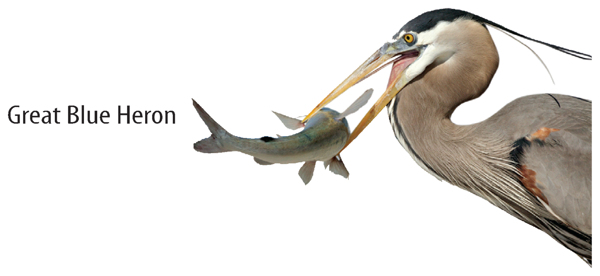
Arthur Morris/Visuals Unlimited/Getty Images
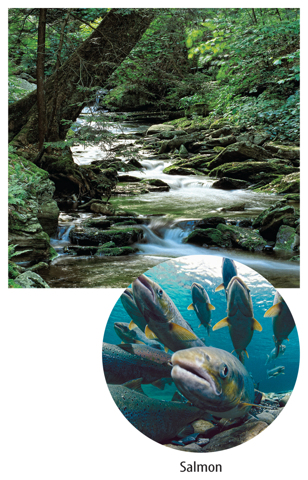
(t) Comstock/PunchStock, (b) Paul Nicklen/NGS/Getty Images
Biodiversity
• Willows, cottonwoods, and other water-loving plants grow along streams and on riverbanks.
• Species adapted to fast-moving water include trout, salmon, crayfish, and many insects.
• Species adapted to slow-moving water include snails and catfish.
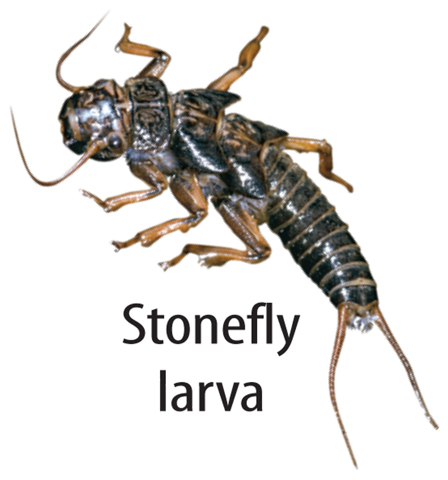
Stephen Dalton/Minden Pictures
Human Impact
• People take water from streams and rivers for drinking, laundry, bathing, crop irrigation, and
industrial purposes.
industrial purposes.
• Hydroelectric plants use the energy in flowing water to generate electricity. Dams stop the water’s
flow.
flow.
• Runoff from cities, industries, and farms is a source of pollution.
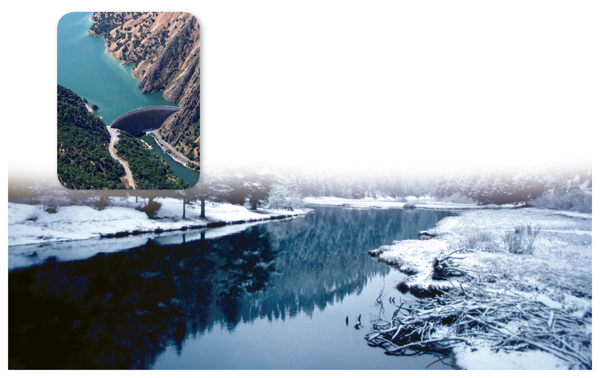
(tl) Dr. Marli Mill/Visuals Unlimited/Getty Images, (b) Medioimages/PunchStock
Freshwater: Ponds and Lakes
Ponds and lakes contain freshwater that is not flowing downhill. These bodies of water form in low areas on land.
• Ponds are shallow and warm.
• Sunlight reaches the bottom of most ponds.
• Pond water is often high in nutrients.
• Lakes are larger and deeper than ponds.
• Sunlight penetrates into the top few feet of lake water. Deeper water is dark and cold.
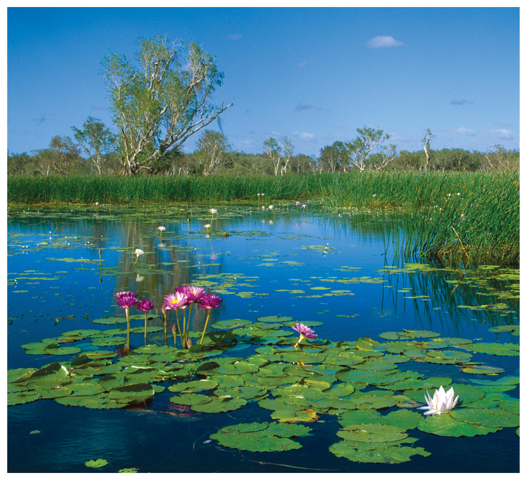
Jean-Paul Ferrero/Minden Picture
Biodiversity
• Plants surround ponds and lake shores.
• Surface water in ponds and lakes contains plants, algae, and microscopic organisms that use
sunlight for photosynthesis.
sunlight for photosynthesis.
• Organisms living in shallow water near shorelines include cattails, reeds, insects, crayfish, frogs,
fish, and turtles.
fish, and turtles.
• Fewer organisms live in the deeper, colder water of lakes where there is little sunlight.
• Lake fish include perch, trout, bass, and walleye.
1.  Reading Check Why do few organisms live in the deep water of lakes?
Reading Check Why do few organisms live in the deep water of lakes?
 Reading Check Why do few organisms live in the deep water of lakes?
Reading Check Why do few organisms live in the deep water of lakes?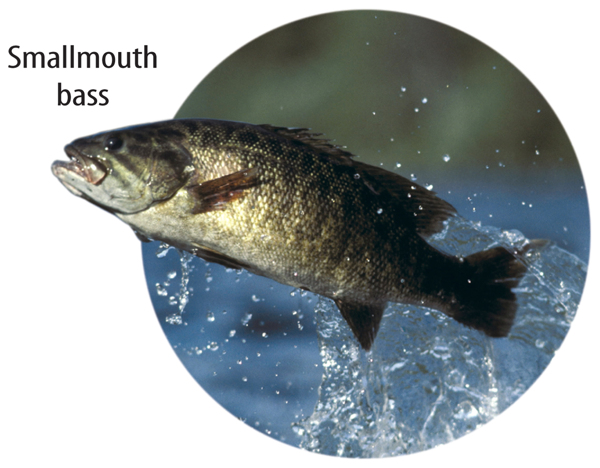
Lynn & Donna Rogers/Peter Arnold, Inc.
Human Impact
• Humans fill in ponds and lakes with sediment to create land for houses and other structures.
• Runoff from farms, gardens, and roads washes pollutants into ponds and lakes, disrupting food
webs.
webs.
2. Key Concept Check How do ponds and lakes differ?
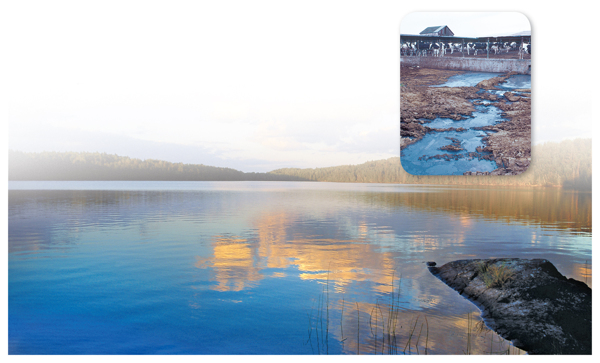
(tr) Photograph by Tim McCabe, courtesy USDA Natural Resources Conservation Service, (b) Image Ideas/PictureQuest
Wetlands
Some types of aquatic ecosystems have mostly shallow water. Wetlands are aquatic ecosystems that have a thin layer of water covering soil that is wet most of the time. Wetlands contain fresh water, salt water, or both. They are among Earth’s most fertile ecosystems.
• Freshwater wetlands form at the edges of lakes and ponds and in low areas on land. Saltwater
wetlands form along ocean coasts.
wetlands form along ocean coasts.
• Nutrient levels and biodiversity are high.
• Wetlands trap sediments and purify water. Plants and microscopic organisms filter out pollution and
waste materials.
waste materials.
Biodiversity
• Water-tolerant plants include grasses and cattails. Few trees live in saltwater wetlands. Trees in freshwater wetlands include cottonwoods, willows, and swamp oaks.
• Insects are abundant and include flies, mosquitoes, dragonflies, and butterflies.
• More than one-third of North American bird species, including ducks, geese, herons, loons, warblers, and egrets, use wetlands for nesting and feeding.
• Other animals that depend on wetlands for food and breeding grounds include alligators, turtles, frogs, snakes, salamanders, muskrats, and beavers.
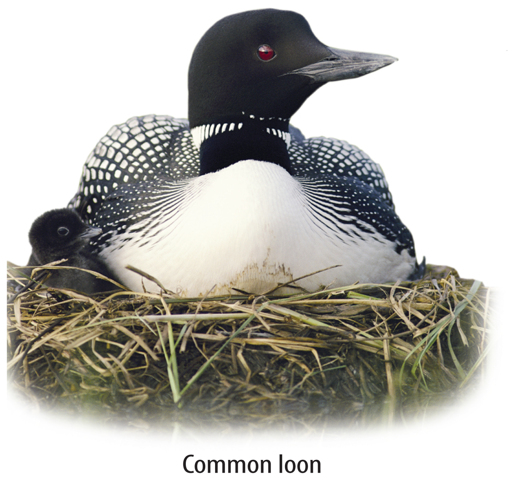
Michael S. Quinton/National Geographic/Getty Images
Human Impact
• In the past, many people considered wetlands as unimportant environments. Water was drained
away to build homes and roads and to raise crops.
away to build homes and roads and to raise crops.
• Today, many wetlands are being preserved, and drained wetlands are being restored.
1. Key Concept Check How do humans impact wetlands?
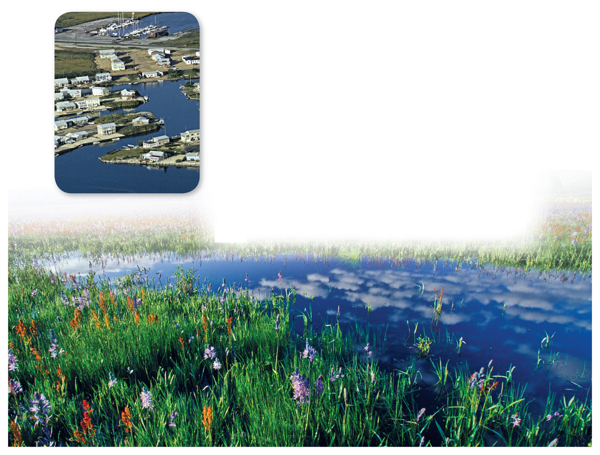
(tl) James L. Amos/Peter Arnold, Inc., (b) Steve Bly/Getty Images
Estuaries
Estuaries (ES chuh wer eez) are regions along coastlines where streams or rivers flow into a body of salt water. Most estuaries form along coastlines, where freshwater in rivers meets salt water in oceans. Estuary ecosystems have varying degrees of salinity.
• Salinity depends on rainfall, the amount of freshwater flowing from land, and the amount of salt
water pushed in by tides.
water pushed in by tides.
• Estuaries help protect coastal land from flooding and erosion. Like wetlands, estuaries purify water
and filter out pollution.
and filter out pollution.
• Nutrient levels and biodiversity are high.
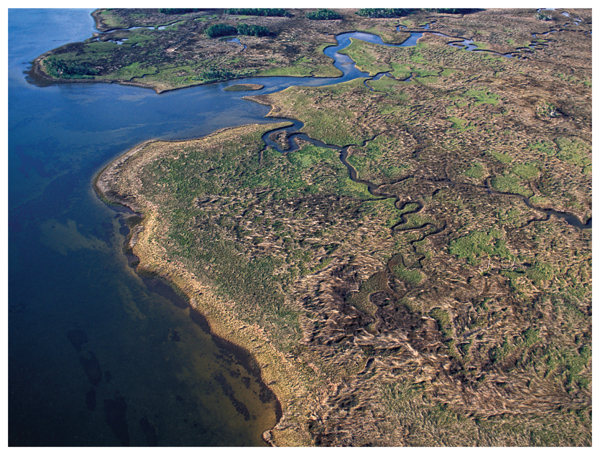
Tom & Therisa Stack/Tom Stack & Associates
Biodiversity
• Plants that grow in salt water include mangroves, pickleweeds, and seagrasses.
• Animals include worms, snails, and many species that people use for food, including oysters,
shrimp, crabs, and clams.
shrimp, crabs, and clams.
• Striped bass, salmon, flounder, and many other ocean fish lay their eggs in estuaries.
• Many species of birds depend on estuaries for breeding, nesting, and feeding.
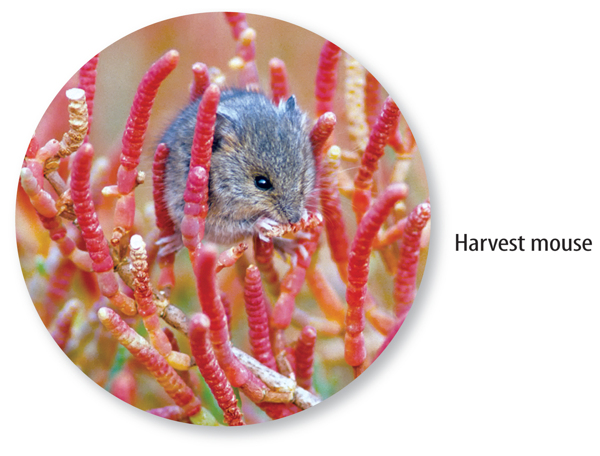
B. Moose Peterson
Human Impact
• Large portions of estuaries have been filled with soil to make land for roads and buildings.
• Destruction of estuaries reduces habitat for estuary species and exposes the coastline to flooding
and storm damage.
and storm damage.

David Noton Photography/Alamy
1
WORD ORIGIN
estuary
from Latin aestuarium, means “a tidal marsh or opening.”
from Latin aestuarium, means “a tidal marsh or opening.”
Ocean: Open Oceans
Most of Earth’s surface is covered by ocean water with high salinity. The oceans contain different types of ecosystems. If you took a boat trip several kilometers out to sea, you would be in the open ocean—one type of ocean ecosystem. The open ocean extends from the steep edges of continental shelves to the deepest parts of the ocean. The amount of light in the water depends on depth.
• Photosynthesis can take place only in the uppermost, or sunlit, zone. Very little sunlight reaches the
twilight zone. None reaches the deepest water, known as the dark zone.
twilight zone. None reaches the deepest water, known as the dark zone.
• Decaying matter and nutrients float down from the sunlit zone, through the twilight and dark zones,
to the seafloor.
to the seafloor.
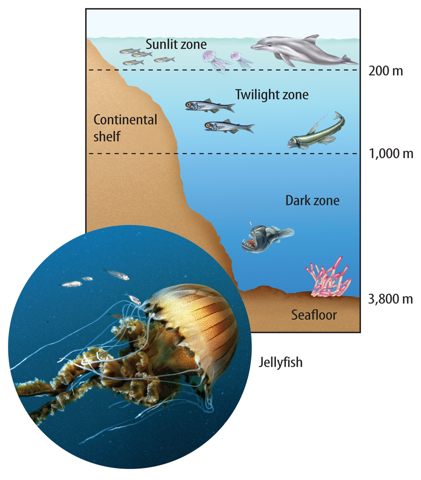
(b) Camille Lusardi/Photolibrary
Biodiversity
• Microscopic algae and other producers in the sunlit zone form the base of most ocean food chains.
Other organisms living in the sunlit zone are jellyfish, tuna, mackerel, and dolphins.
Other organisms living in the sunlit zone are jellyfish, tuna, mackerel, and dolphins.
• Many species of fish stay in the twilight zone during the day and swim to the sunlit zone at night to
feed.
feed.
• Sea cucumbers, brittle stars, and other bottom-dwelling organisms feed on decaying matter that
drifts down from above.
drifts down from above.
• Many organisms in the dark zone live near cracks in the seafloor where lava erupts and new s
eafloor forms.
eafloor forms.
1.  Reading Check Which organisms are at the base of most ocean food chains?
Reading Check Which organisms are at the base of most ocean food chains?
 Reading Check Which organisms are at the base of most ocean food chains?
Reading Check Which organisms are at the base of most ocean food chains?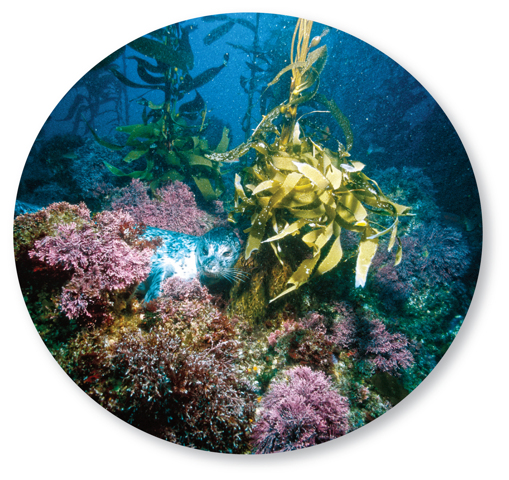
Gregory Ochocki/Photo Researchers
Human Impact
• Overfishing threatens many ocean fish.
• Trash discarded from ocean vessels or washed into oceans from land is a source of pollution. Animals such as seals become tangled in plastic or mistake it for food.
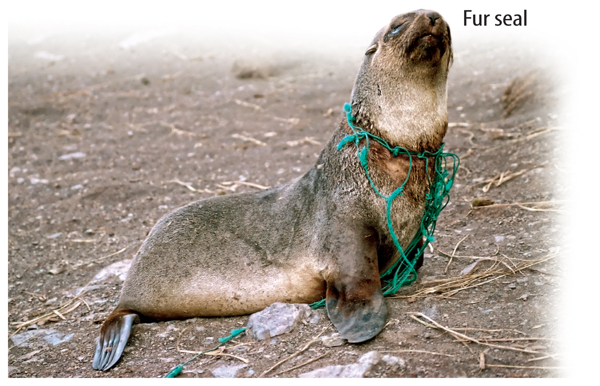
Doug Allan/Getty Images
Ocean: Coastal Oceans
Coastal oceans include several types of ecosystems, including continental shelves and intertidal zones. The intertidal zone is the ocean shore between the lowest low tide and the highest high tide.
• Sunlight reaches the bottom of shallow coastal ecosystems.
• Nutrients washed in from rivers and streams contribute to high biodiversity.
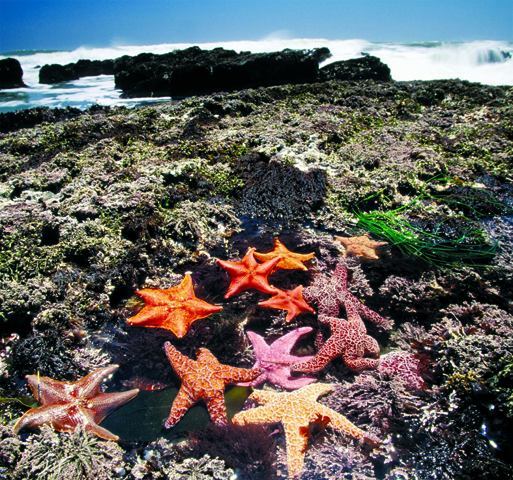
Gavriel Jecan/Photolibrary
Biodiversity
• The coastal ocean is home to mussels, fish, crabs, sea stars, dolphins, and whales.
• Intertidal species have adaptations for surviving exposure to air during low tides and to heavy waves during high tides.
Human Impact
• Oil spills and other pollution harm coastal organisms.
Ocean: Coral Reefs
Another ocean ecosystem with high biodiversity is the coral reef. A coral reef is an underwater structure made from outside skeletons of tiny, soft-bodied animals called coral.
• Most coral reefs form in shallow tropical oceans.
• Coral reefs protect coastlines from storm damage and erosion.
Biodiversity
• Coral reefs provide food and shelter for many animals, including parrotfish, groupers, angelfish, eels, shrimp, crabs, scallops, clams, worms, and snails.
Human Impact
• Pollution, overfishing, and harvesting of coral threaten coral reefs.
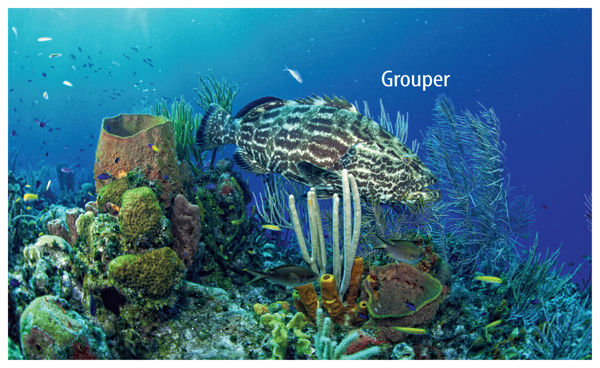
Comstock Images/PictureQuest
Lesson Review
Visual Summary
Earth has seven major land biomes, ranging from hot, dry deserts to cold, forested taigas.
Half of Earth’s species live in rain forest biomes.
Temperate deciduous forests are the most common forest biome in the United States.
Freshwater ecosystems include ponds and lakes.
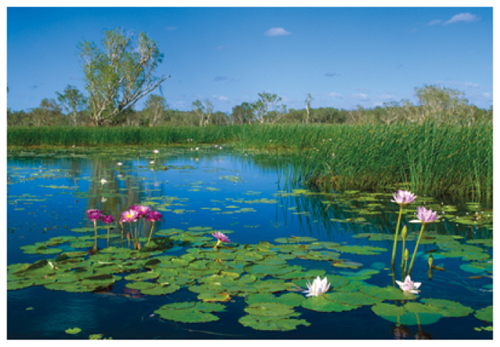
Jean-Paul Ferrero/Minden Picture
Wetlands can be saltwater ecosystems or freshwater ecosystems.
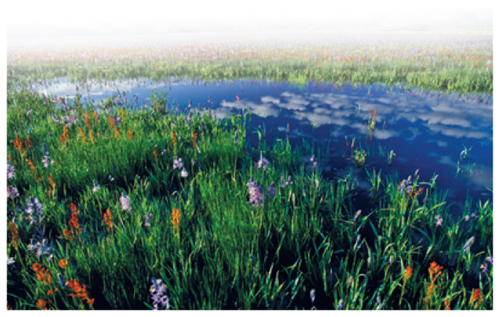
Steve Bly/Getty Images
Coral reefs and coastal ecosystems have high levels of biodiversity.
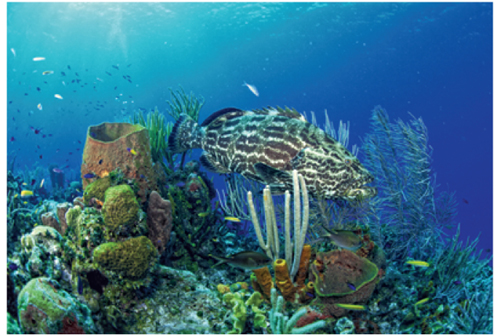
Lesson Assessment
Use Vocabulary
1. Define biome using your own words.
2. Distinguish between tropical rain forests and temperate rain forests.
3. A cold, treeless biome is a(n) __________.
4. Define the term salinity.
5. Distinguish between a wetland and an estuary.
6. An ocean ecosystem formed from the skeletons of animals is a(n) __________.
Understand Key
Understand Key
Concepts
7. Explain why tundra soil cannot support the growth of trees.
8. Give examples of how plants and animals adapt to temperate deciduous ecosystems.
9. Where would you find plants with stems that can store large amounts of water?
A.desert
B.grassland
C.taiga
D.tundra
10. What does the pink area on the map below represent?
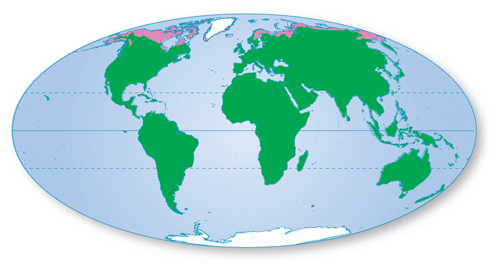

A.taiga
B.tundra
C.temperate deciduous forest
D.temperate rain forest
11. Where would you find trees that have no leaves during the winter?
A.estuary
B.tundra
C.temperate deciduous forest
D.temperate rain forest
12 Which biomes have rich, fertile soil?
A.grassland and taiga
B.grassland and tundra
C.grassland and tropical rain forest
D.grassland and temperate deciduous forest
13. Which ecosystem contains both salt water and freshwater?
A.estuary
B.lake
C.pond
D.stream
14. Describe what might happen to a coastal area if its estuary were filled in to build houses.
15. Which is NOT a freshwater ecosystem?
A.oceans
B.ponds
C.rivers
D.streams
16. Where would you find species adapted to withstand strong wave action?
A.estuaries
B.wetlands
C.intertidal zone
D.twilight zone
17. Which ecosystem has flowing water?
A.estuary
B.lake
C.stream
D.wetland
18. Which ecosystems help protect coastal areas from flood damage?
A.estuaries
B.ponds
C.rivers
D.streams
Interpret Graphics
119. Determine What is the average annual rainfall for the biome represented by the chart below?
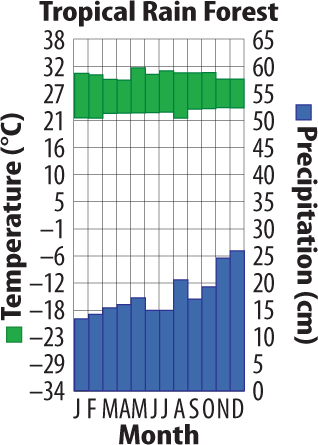

20. Summarize Information Copy the graphic organizer below and fill it in with animals and plants
of the biome you live in.

of the biome you live in.

Critical Thinking
21. Briefly describe the characteristics of Earth's seven major land biomes. List examples of plants
and animals that live in each biome.
and animals that live in each biome.
22. Plan an enclosed zoo exhibit for a desert ecosystem. What abiotic factors should you consider?
23. Recommend one or more actions people can take to reduce habitat loss in tropical and taiga
forests.
forests.
24. Compare mammals that live in tundra biomes with those that live in desert biomes. What
adaptations does each group have that help them survive?
adaptations does each group have that help them survive?
25. Analyze You are invited to go on a trip to South America. Before you leave, you read a travel
guide that says the country you will be visiting has hot summers, cold winters, and many wheat
farms. What biome will you be visiting? Explain your reasoning.
guide that says the country you will be visiting has hot summers, cold winters, and many wheat
farms. What biome will you be visiting? Explain your reasoning.
26. Interpret Graphics The following climate data were recorded for a forest ecosystem. To which
biome does this ecosystem likely belong?
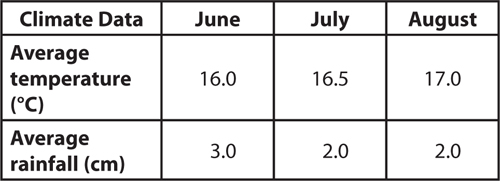
biome does this ecosystem likely belong?

27. Earth contains a wide variety of organisms that live in different conditions. How do Earth’s
biomes and ecosystems differ?
28. Observe two biomes. How do the different environments of these biomes support different
varieties of organisms? Explain.
varieties of organisms? Explain.
Science is Awesome
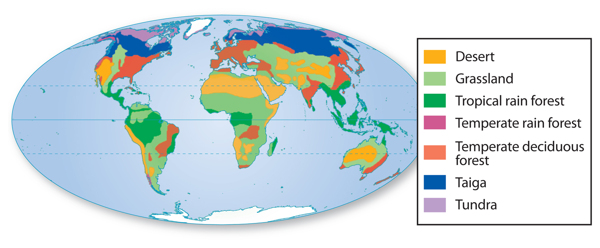



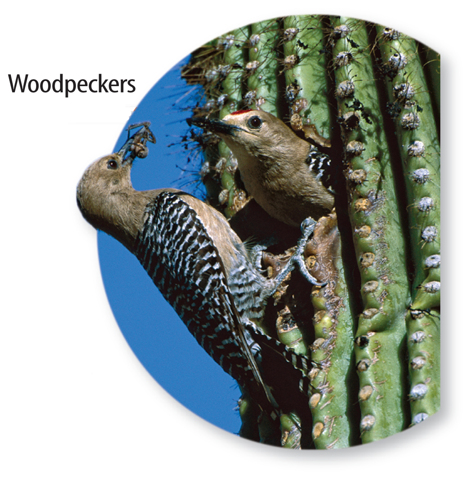
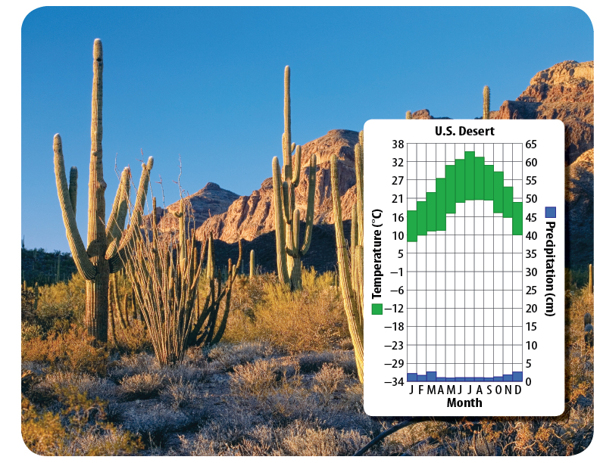
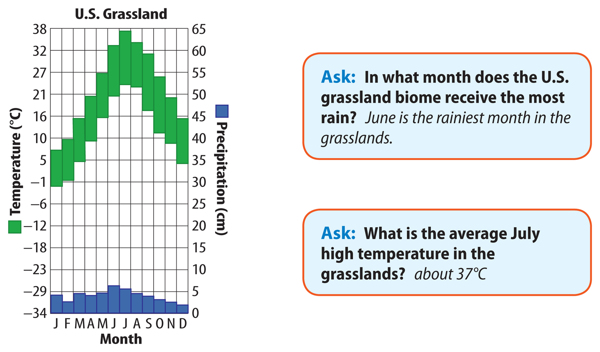
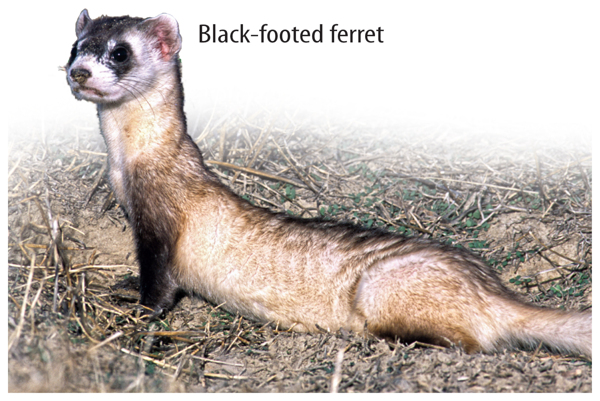
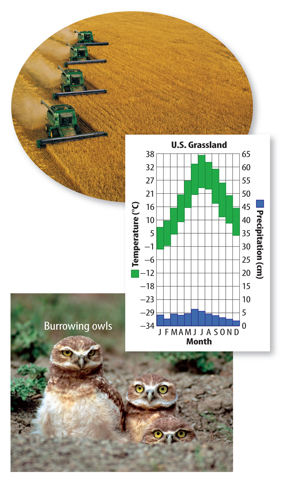
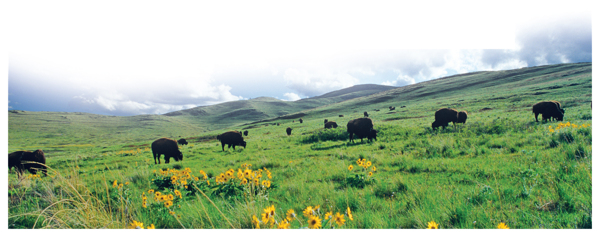
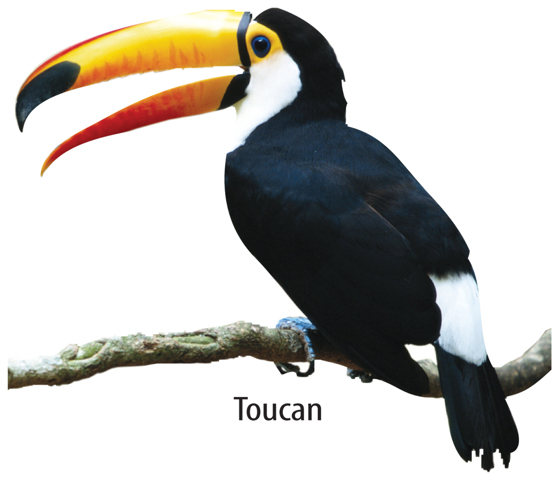
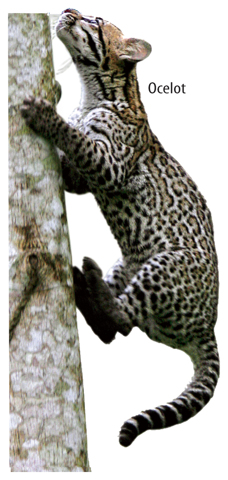
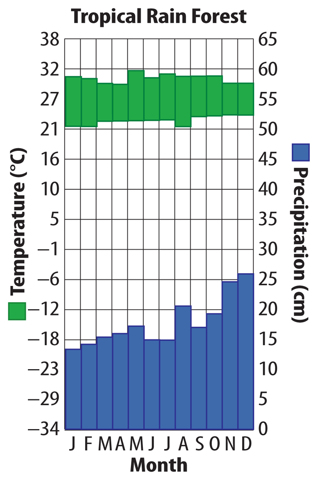
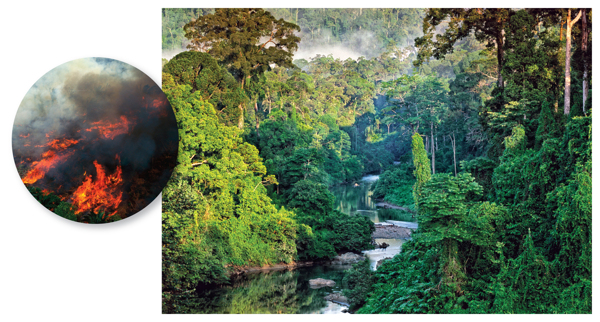
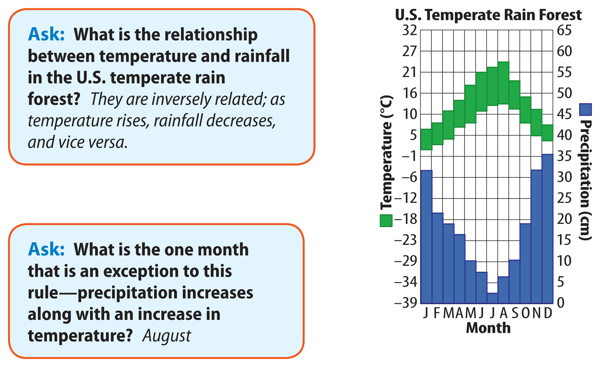

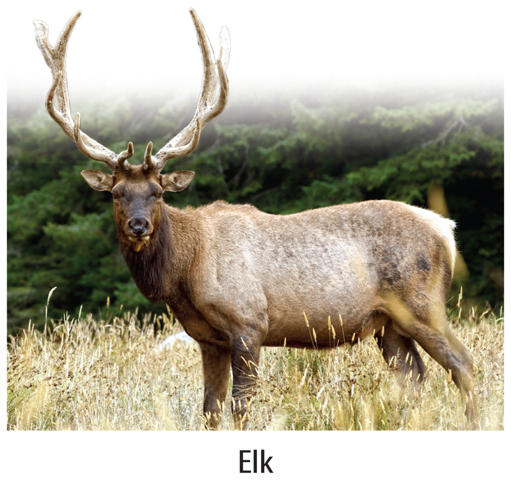
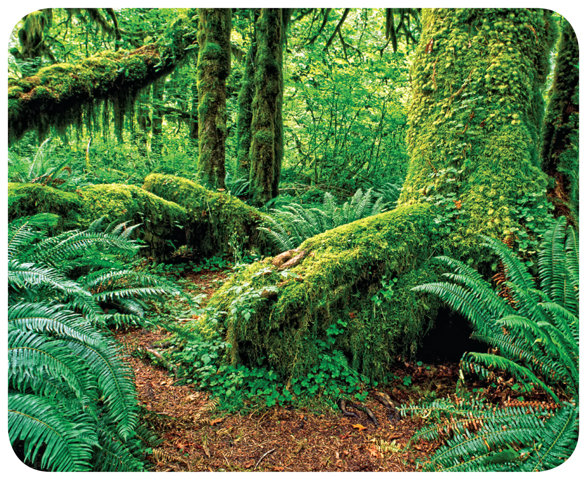
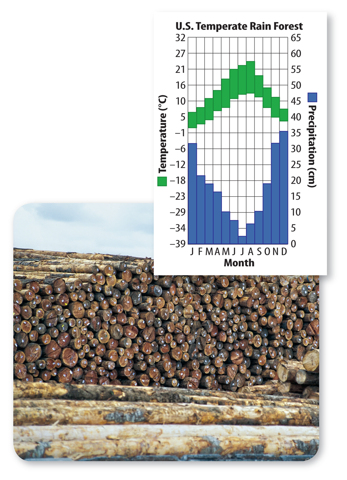
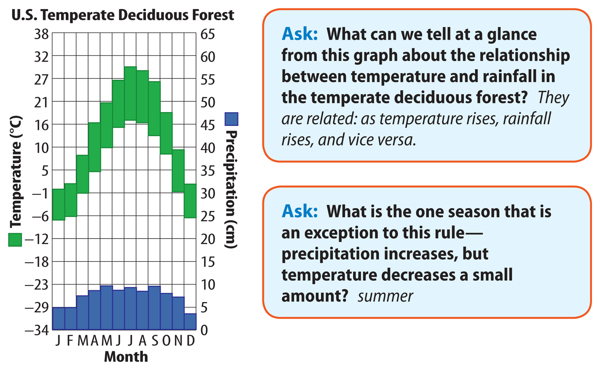
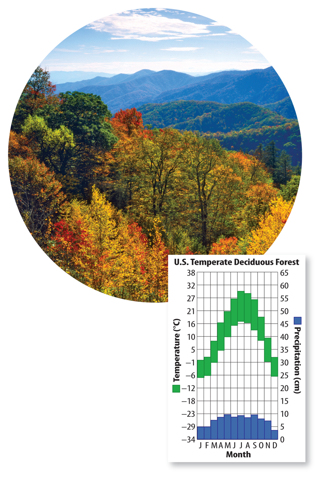
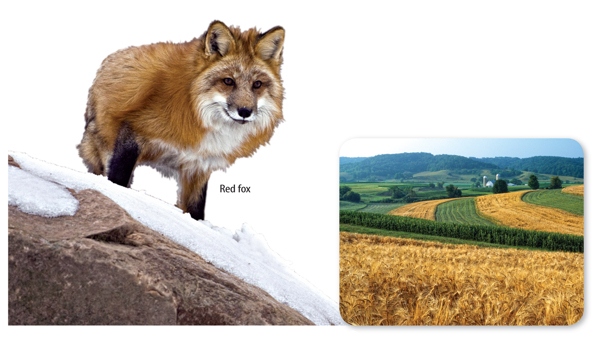
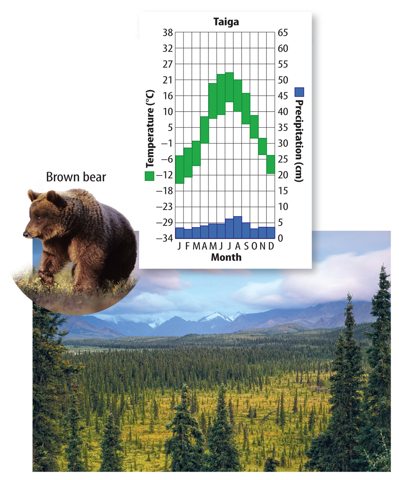
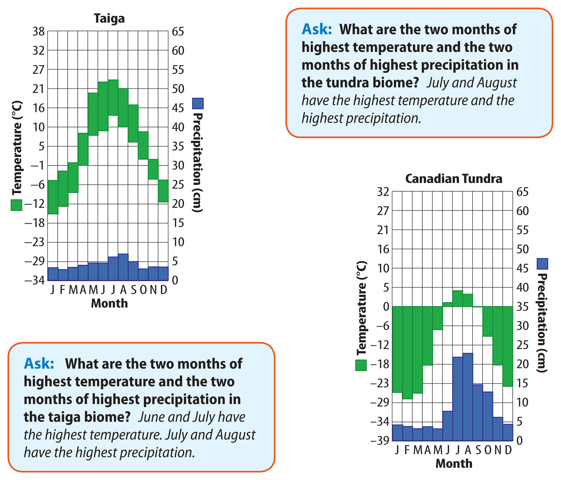
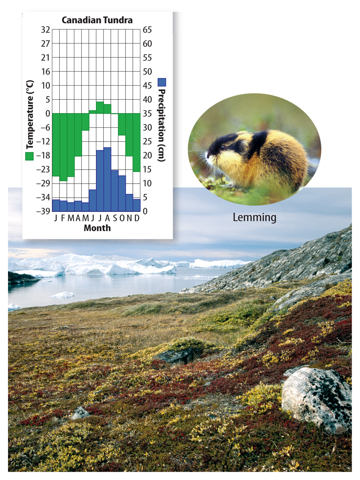



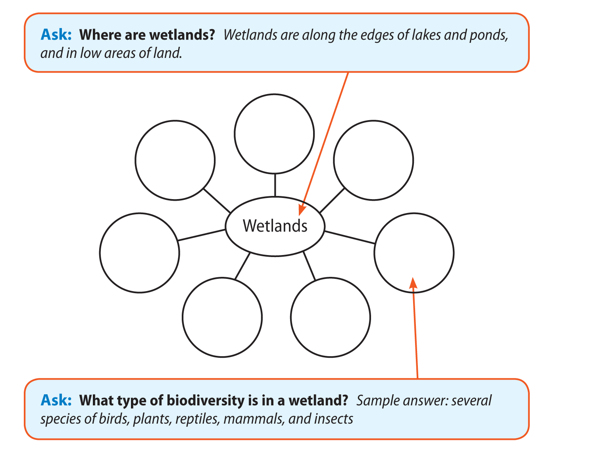
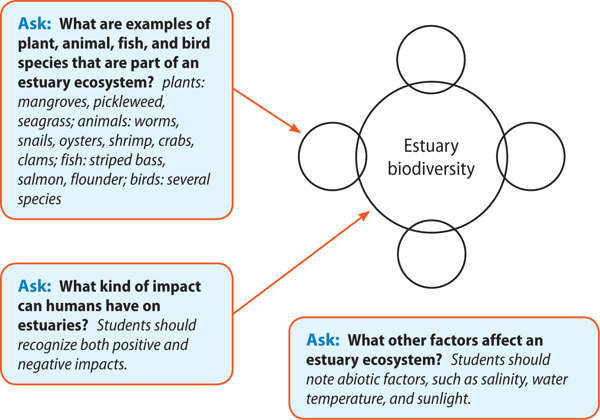

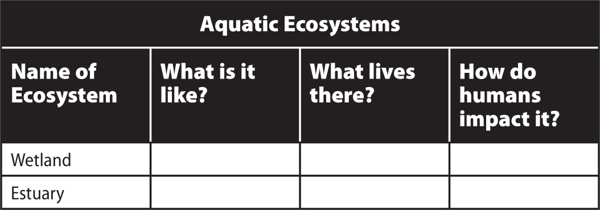
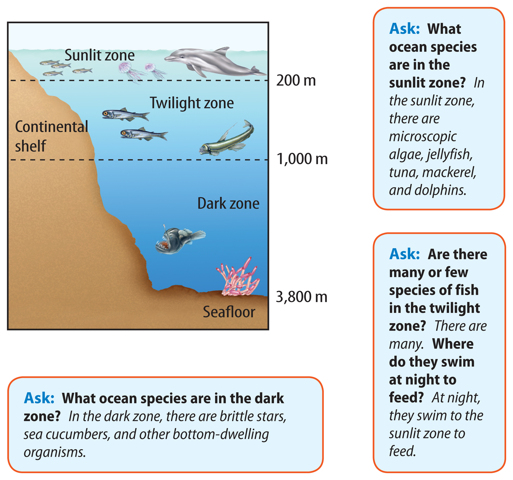
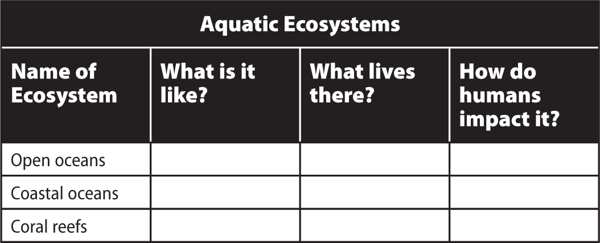
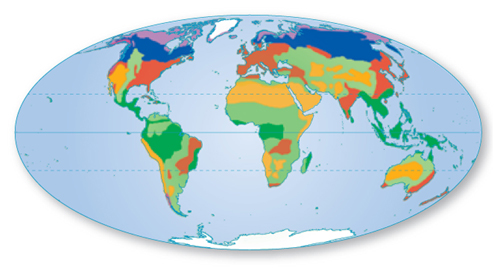
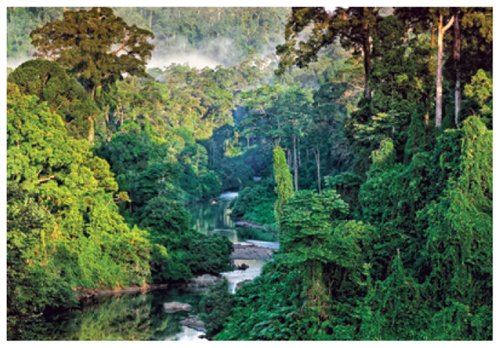
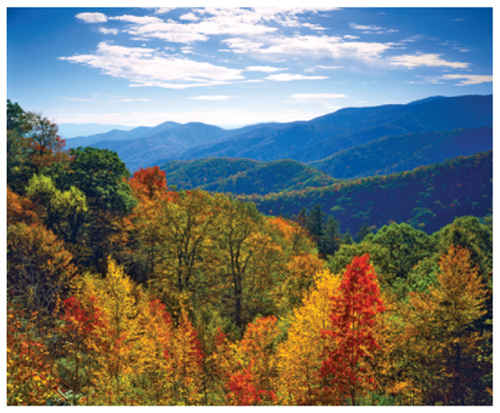
1 comments:
Amazing website curry munching betas! Betaman is proud of you. May Mr. Venkata find u in ur dreams!!!! :)
Post a Comment